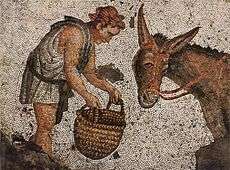Great Palace Mosaic Museum

The Great Palace Mosaic Museum (Turkish: Büyük Saray Mozaikleri Müzesi), is located close to Sultanahmet Square in Istanbul, Turkey, at Arasta Bazaar. The museum houses mosaics from the Byzantine period, unearthed at the site of the Great Palace of Constantinople.
History
The museum hosts the mosaics used to decorate the pavement of a peristyle court, dating possibly to the reign of Byzantine emperor Justinian I (r. 527-565). It was uncovered by British archaeologists from the University of St Andrews in Scotland during extensive excavations at the Arasta Bazaar in Sultan Ahmet Square in 1935-1938 and 1951-1954. The area formed part of the south-western Great Palace, and the excavations discovered a large peristyle courtyard, with a surface of 1872 m², entirely decorated with mosaics. It was at this point that the Austrian Academy of Sciences, supervised by Prof. Dr. Werner Jobst, undertook to study and preserve the famous palace mosaic and to carry out additional archeological examinations (1983-1997) within the scope of a cooperative project with the Directorate General of Monuments and Museums in Turkey.
Gallery
 Floor mosaic of a woman carrying a pot (c. 5th century)
Floor mosaic of a woman carrying a pot (c. 5th century) Floor mosaic of a child and a donkey (c. 5th century)
Floor mosaic of a child and a donkey (c. 5th century)
See also
External links
| Wikimedia Commons has media related to Great Palace Mosaic Museum. |
- Byzantium 1200 | Mosaic Peristyle
- Istanbul Mosaic Museum Photos
- Some 50 pictures, so most of the scenes
Coordinates: 41°00′16″N 28°58′36″E / 41.00444°N 28.97667°E